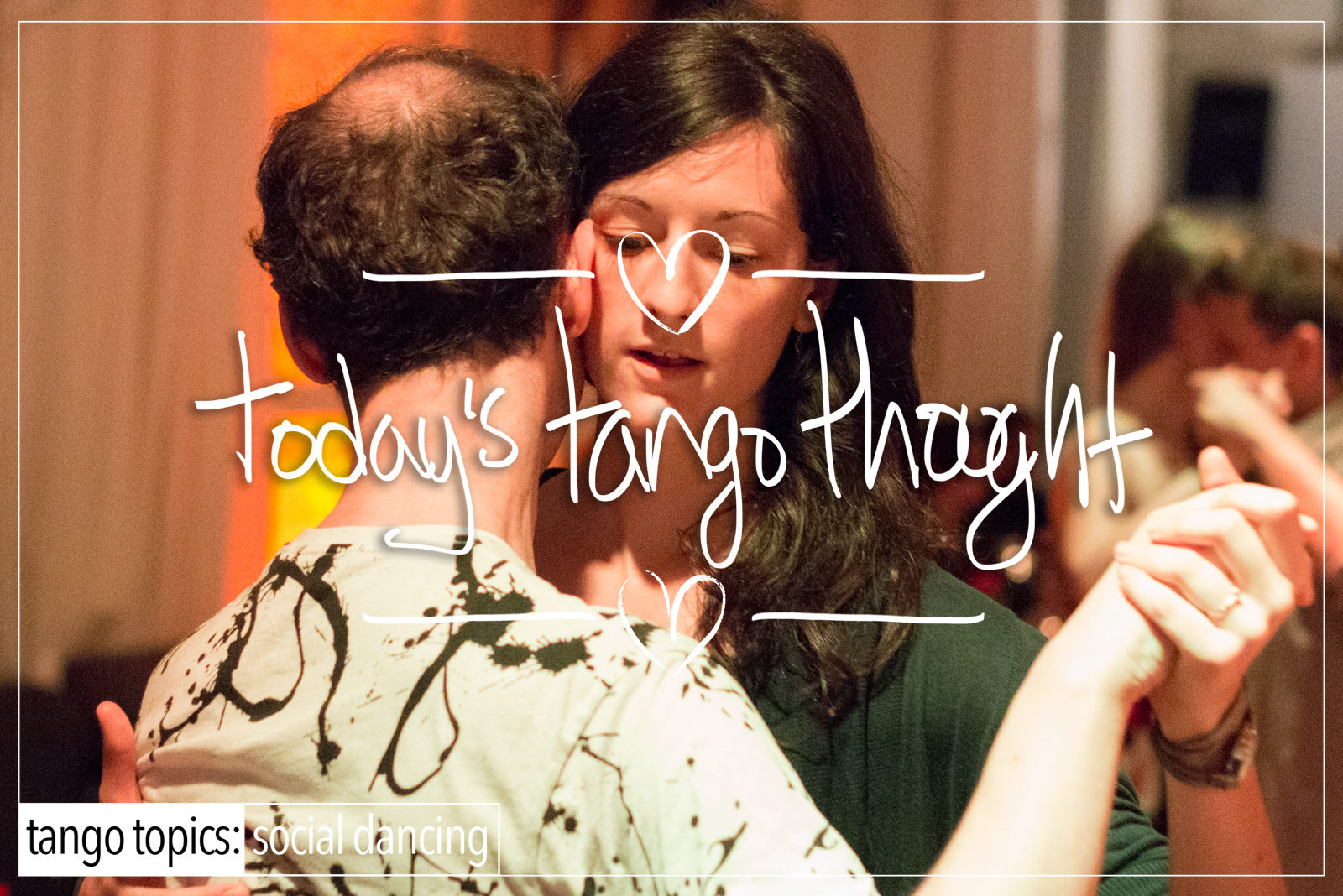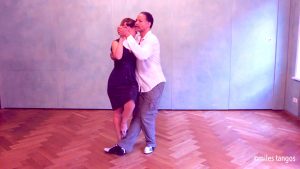From time to time you will see people attempting, and sometimes succeeding, to dance their non-gendered role. Sometimes it looks a little funny to you for a variety of reasons, sometimes it looks fine, and sometimes you really could give a damn. For some people that try these things out, they’re doing it to see how things feel, how they work, and/or whether or not they can do it. Sometimes it’s just for kicks or laughs. And sometimes, for those people that are serious about dancing on the side of the embrace, it’s about a full and complete experience, and/or honing their skills, expanding their capabilities, and most of…believe or not, creating a scenario whereby they’re in a state of readiness for anything and anyone that comes their way!
To be fair, some people have a real issue with other people dancing their non-gendered role. Why ? Because they feel it violates their idea of what Tango is about. Tango is danced between a man and a woman. Not two men, and not two women. Not a man Following, and for some, not a woman leading. This idea of the dance being that, and only that, is shall we shall … ummmmm…’quaint, if not antiquated’. Other people see no issue with what has been termed ‘role swapping‘ all because it looks normal to them. Why ? It depends largely on how they were exposed to learning the dance in the first place. Who their teacher was and whether or not that teacher immediately exposed them to the idea of leading and following and swapping roles to begin with. Whatever your vantage point on this issue, there are a few things that you should know before you click away from Today’s Tango Thought.
You may find what’s about to be said hard to believe, considering the social mores of today, and the prevalence of how often you see people dancing their non-gendered role: Until rather recently (a little more about 20 years ago) the very idea that a woman leading at Milonga was nothing short of absolute social heresy! You can thank two important American luminaries, and one Dutch, for that little gift! The luminaries ? Daniel Trenner, Rebecca Shulman, and Eric Jorrison (and really his creation of El Corte that changed everything about Tango in Europe).
Moving on, let’s get right to the heart of the question, “Why on earth would anyone want to learn the other side of the embrace ?“. The answer to that question is actually not a singular answer, it’s actually multiple reasons.
Five Reasons. There are 5 reasons why you learn the other role that you may or may not disagree with. They are as follows:
1.) The Full Picture or The Full Conversation. The other role gives you a much more complete picture of the dance vs. your genderized version of the dance. Right now, you are dancing one role, and as a result, you’re only hearing one side of a conversation, your side. You’re missing the other half! How can you understand the entire conversation if you all you hear is yourself talking ??!?!?
2.) Empathy! It creates ‘empathy’ in you for what the other person has to do. Never again will you blame the Other Role for failing to execute X, Y, and/or Z, until you’ve actually done the job yourself. As a result of this empathy, you will begin to be far more patient with your dance partners, and a lot more gracious.
3.) The Ying/Yang Principle. Imagine a Ying/Yang Symbol. Note that one side is white, and the reciprocal is black. Also note that there is a kernel of white inside the black at its center, and vice versa with the white half. If we name the halves ‘lead’ and ‘follow’, note the kernel of leading is following, and the kernel of following is leading!! One is the other.
4.) Faster Acquisition of the Material. You will acquire the dance that much faster if and only if you are learning both roles at the same time.
5.) Hyper-Awareness. You will acquire a greater sense of awareness of the dance, of your role, and more importantly how you engage in the dance because you are taking in the other side of the equation. For example, your embrace! What you think of as your embrace today, will change because of your perception of what has to occur from the learning the other side of the embrace. You will start to see that less pressure, less force, less rigidity in the embrace is an absolute requirement going forward. No more hanging, no more pulling, no more pushing that you weren’t even aware that you were doing! Hence the Awareness part!
For some Female Followers, they believe that the other side fo the Embrace is just ‘too hard‘. They see Male Leads that go through frustration and exasperation, and quite literally ‘sweating bullets’ to not screw up. And they think to themselves, “Why on earth would I want to put myself through that !?!?!?“. There is some validity to this line of reasoning. For some Female Followers, their entire world is full of control and the last thing they want to do is control something else, or have to manage something or someone else. Uuuugh! So they’d rather “let go and just relax and let someone else do the work…” Again, a fallacy that no one wants to dance with, better known as the ‘Dead Follower’. “Here, let me hang on you and you pull me around the room while I ‘relax’ in your embrace, ok ?”. Not.
For some Male Leads, they believe that learning the other role may be seen as eroding their masculinity or their public persona. Mind you this is a perception, there’s no basis in fact for that idea at all. But it’s a perception that keeps many men from exploring the techniques that can turn them into far more desirable dancers. For some Male Leads, learning to Follow, they quite literally don’t see that anyone is going to want to lead them, or dance with them, so what’s the benefit ?!?!? Honestly, every woman in the room, eventually! Assuming that the role reversal does its job!
The Benefits. There are major benefits to learning the other role that isn’t listed above.
a.) From a Leading perspective, one thing that you’re going to want to have access to is the ability to execute every Back Sacada known to man as a Lead. However, in order to execute them, you’re going to need to learn how to do a Linear Ocho! Why ? Because, generally, the Lead’s Back Sacada is in Over-Rotation, and that Over-Rotation is based on the skillset of Applied Disassociation. And the Applied Disassociation is the Engine of the Ocho!
b.) From a Following perspective, learning to lead will give you access to the Role of the Active Follower! Why ? Mostly because you will know exactly, with pin-point precision, what is being asked of you and why! Which thereby gives you the ability to deliver precisely that, and in a way that makes the Lead’s job that much easier and far more effortless. Why ? Because you’ve done the job yourself!
c.) Sensitivity. You will gain a far greater sense of physiological sensitivity and kinesthetic awareness of yourself, and more importantly your partners, as well as your actions and your partner’s actions that will seem overwhelming at times. And yet, that sensitivity will do far more for your abilities than you can possibly imagine it doing at this juncture.
Another upside of learning the other side of the embrace, and that is that you can, not that you will, continually dance all night long. You have the ability to dance with anyone, at any time, anywhere. You won’t be reliant on whether or not there are enough of the opposite gender in the room to dance with, you can simply change your mindset and dance the other role!
These are three primary reasons why you want to learn the other side of the embrace. They’re not the only ones but these are pretty good motivators for learning your non-gendered role. The reality is that Tango is work. It is the Unending Onion of social dances. Once you pass through one layer, there is always another effing layer just waiting for you. There’s always something else to learn.
There’s one more benefit of learning the other role is that you will as a side benefit be a far more desirable dancer than you were before. While it may not change your Tango Baggage, you will be perceived in your local community as being open to change and be seen as changing or willing to change what you’ve been doing. Which has an effect on your Tango Baggage as well as your abilities, and your social standing in the Tango Communities that you currently dance in!
The Downside to learning the other side of the embrace. Several actually. One of which is that once people know you can dance other role, they may actively avoid you. The belief is that you’ll become too bossy, or want to control the dance with them to dance with you. Again, this is a perception, not reality.
Stil,l another is that from a Following perspective that you’ll be too big, and/or too clunky to dance with. You’ll move slowly, you’ll move like you’re swimming in quicksand. There’s some truth to this. All those that Follow have had to learn that the expediency mantra: Move Your Ass!!! Or as Tango Topics puts it: I Move Me! Eventually, you will learn that you must take responsibility for your dancing skills so that you are not a burden to your dancing partners. Oddly enough this skillset also translates back to your own gendered role in a myriad of different ways. Most notably that it helps you to manage the partnership, and to learn to listen to your partner and what you’re asking them to do and in how you’re asking them to do it! Mostly the ‘how’, and later on the ‘what’ you’re asking them to do.
Still one more is that from a Leading perspective that you won’t know what to do. Yup. There’s truth in that. But then again, that is the plight of every beginner. You must learn how to speak a new language, and then later on so that you can put that new language into your own words so that you don’t sound like a language school tape but rather speaking your own mind!
There is one more downside to this process of role swapping, and that’s that for a good number of people that go down this road, they become more critical of themselves, seemingly ‘harsh’ critical behavior, and worse in others. This is actually desirable in one respect and less than desirable in another. The desirable part is that they will finally start to see errors in their abilities that have quite literally held them back from becoming the dancer they’ve always wanted to be with respect to Tango. The downside is that same critical behavior, if left unguided and unchecked, can become divisive and self-destructive. Guidance, openness, and a healthy dose of reality on a regular basis is what’s required here. 😉 (See “Giving (and Receiving) Feedback“).
The Primary Fallacy. There is one fallacy that comes with this, and it comes in the form of most Male Leads that think or believe that if they learn to Follow that they must wear heels in order to do so. That is not true. Not even close to being true. No, you can simply remove your shoes and wear socks so that your feet slide when they need to! There is some truth, however, that a Female in a pair of heels will find it slightly more challenging to Lead then in a pair of flats. In both cases, removing one’s gendered shoes from the equation is the answer!
Tango Topics Opinion. Learn it. Know it. Dance it. And above all, have fun with it.
Here’s a fun fact in case you were unclear: Chicho can, and does Follow. So does Gustavo, as do most of the traveling Sebastians…pick one. Here’s another, most if not all of the Followers that you currently admire…pick one, nearly all of them lead! Noelia, she leads. As does Juana Sepulveda and a host of others. So if they can do it, what’s stopping you ?
Here’s another fun fact, you’re going to talk yourself out of doing this. In fact, you’ve already done it! You’re going to claim that you’re too old, that you’re too new, that you’re this or that. Anything to deflect from actually doing what you know damned right well will improve your abilities. And you can not allow that to occur. You sit there reading tango blogs, watching tango videos, watching other people dance, talk to your friends about this or that dancer, wishing that you could …. and yet you do nothing about it. Here’s a simple way that you can start that process of improving your dance for the better, immediately.
The reality is that the more that you know, the more that you can bend the dance into the ideas, shapes, and concepts that you can make your own. It’s a little like learning a language. If you stop with just a few phrases, which is what most people do, then you’re quite literally limiting yourself to barely being understood. Versus, actually becoming fluent in that language!
Learning both roles is being fluent in the language that is Argentine Tango.
The only thing that’s stopping you from doing this today is your own ego.
YES! Learning the other role will take some time. You’re not going to master this stuff over night, and truthfully you’re going to suck at it for while. A long while in reality. Everything you thought you knew about the dance will be drawn into question. All those beginner lessons you had to start with, you’re going to see that you need to go back to them and relearn everything all over again. A beginner class looks so daunting and your ego will be in your way. However, the benefits of learning the other role far outweigh your fragile ego.
YES! Learning the other side of the Embrace will take a bit of money. How much ? About the same amount that you’ve spent so far on learning your gendered role!
As a newly minted Male Follower, you’re going to be heavy, slow, and non-responsive. You’re going to squeeze, hang, pull and push. You’re going to ‘thud’ everywhere. You’re going to do all the things that you have criticized every Follower in your life of doing, only now you’re the one that’s doing it. Nothing like a mirror to show you the err of your ways! Talk about a wake-up call!
As a newly minted Female Lead, you’re going to compress the embrace, you’re going squeeze your Followers, you’re going to get all pissy when they don’t follow what you led because you didn’t actually lead it, you implied it because you weren’t clear with them. You’re going to make all the mistakes that every Lead that you’ve ever bitched about doing to you, you’re going to do with them.
At first.
And then, magically change will occur. Yes, you’re going to suck at it from the beginning. And then something will happen, a small thing, a bit of awareness will occur. It will be tiny, insignificant really. But that’s all that’s needed, and the rest of your world will start to unravel and then be revealed towards a wonderful, and quite possibly better Tango future.
There are some that will not support you in this endeavor. They’ll question you and make you feel like an idiot for even trying. There will be some support from the strangest places, people from the unlikeliest of corners. And there will be those people that won’t give a rat’s damn.
There will also be the nagging thought that you have to perfect your gendered role first and foremost before you can even attempt this challenge. That is without a doubt one of the most idiotic and self-defeating lines of reasoning approaching bullshit that has ever been stated. That’s like saying that you can only start to learn Spanish after you’ve already landed in Argentina, and have been there for a few months!
No! You can start today, right now.
So how do you start ? Go to a beginner class. Start there. Or if you’re already in classes, ask to swap roles with your partner for the vocabulary that’s being taught so that you can understand the idea that’s being presented. That’s probably the best tool right there for starting the process of learning the other role.
Understand something, while you may never, ever socially dance the other role, that doesn’t mean you can’t learn it, and understand it so that it can help you with your gendered role. There will be a clear and definitive effect on you as a dancer learning the other side of the embrace. You will start to see parallels in what you’ve been doing all along. You will also start to see errors that you’ve been generating that you didn’t realize you were generating. And yes, sadly, you will feel inept for about 10 minutes (ok, who are we kidding, you’re going to feel like a fraud and inept for the rest of your tango days). And yes you will have to get over it. There is a phase of this stuff that you’re going to feel like an idiot for even trying. That cannot be helped except to say that when you started learning tango to begin with you did exactly the same thing, the only difference now is that your ego is in the way.
There is one more monster plus to learning the other side of the embrace. Way more partners to dance with! That’s it right there. Female Followers are always complaining that there aren’t enough leads. And now there will be! Male Leads are always wanting to expand their capabilities. Well here’s a challenge for you: Learn to do Linear Ochos without hanging, pulling, pushing, or thudding! Good luck with that! And then try to hit those nasty reverse back sacadas after about 3 or 4 months of Linear Ocho Exercises. You’re welcome!
Have you ever wondered what it’s like to dance with X, but because you’re the same gender as X you’ll never know why X gets all the dances ? Now you will know why! Mind you there are several other factors that may prevent you from being ready to dance with X. Most notably, time, and work, and practice. However, there may come a day and a time when X is open to dancing with you and wouldn’t it be nice to swap shoes and go for a spin and to answer that question ?
One more piece of advice, have fun, smile, and yes you do want to take this stuff seriously. This is your dancing life that you’re playing with here, and you want to make that dancing life as rich and as amazing as you can make it. This is one way to increase the possibility for amazement to happen, learning the other side of the embrace!
- Glossary: Applied Disassociation
- Glossary: Disassociation
- Glossary: Active Follower
- Glossary: Over-Rotated Ochos
- Glossary: Baggage
- Glossary: Linear Ochos
- Glossary: Vocabulary
- Glossary: Pressure
- Glossary: Rigidity
- Glossary: Feedback
- Glossary: Milonga
- Glossary: Pulling
- Glossary: Pushing
- Glossary: Embrace
- Glossary: Leading
- Glossary: Constriction
- Glossary: Sacada
- Glossary: Practical Tango Advice
- Glossary: Lead
- Glossary: Force
- Glossary: Molinete
- Glossary: Ochos
- Glossary: Open Embrace
- Glossary: Close Embrace











